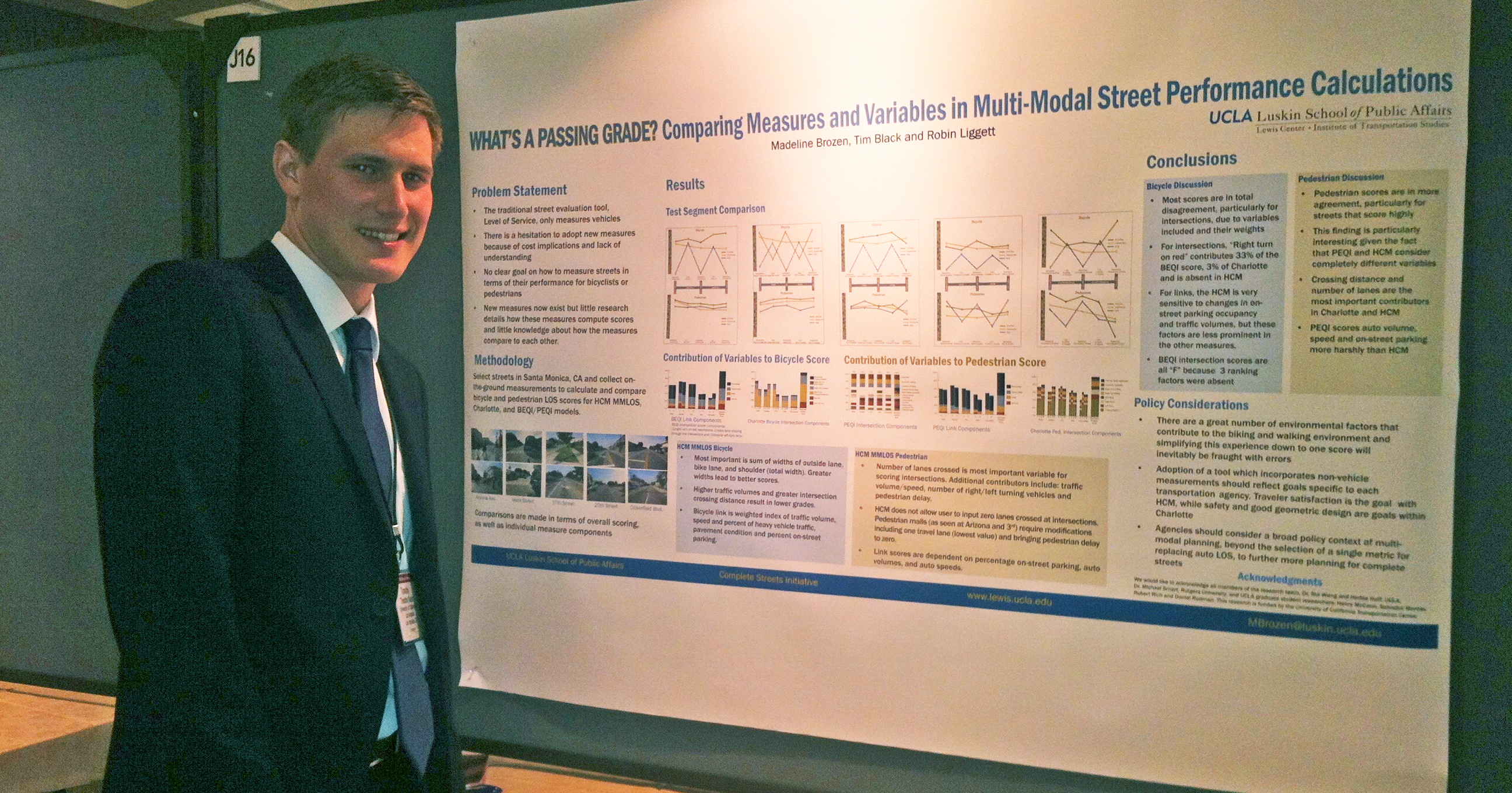By Adeney Zo
UCLA Luskin student writer
A group of Urban Planning students looking to expand their knowledge and professional connections in the transportation world made the trip to the 93rd annual meeting of the Transportation Research Board in Washington D.C., earlier this month.
The TRB annual meeting is a massive event, with around 12,000 participants and 800 different sessions spanning the width and breadth of transportation studies each year. Attending this event offered the UCLA Luskin students an opportunity to meet a mix of professionals and academics working on issues and projects similar to their own.
One student presenter, Jaimee Lederman, recalled, “This conference really gave me the chance to talk to people I normally couldn’t gain access to. For example, I had problems getting data from people in the insurance industry because they are not easy to contact, but there was a woman there who happened to be the head of an insurance company.”
Fellow student Kelcie Ralph agreed that the networking opportunities at the program are invaluable: “My first year, I tried to go to as many sessions as possible and drilled myself into the ground just to see everything. This year, I scaled back and focused on networking. I had the opportunity to attend a women’s reception that became an amazing networking opportunity for me to meet other women in transportation.”
Four Urban Planning students — master’s student Timothy Black and doctoral students Trevor Thomas, Ralph and Lederman — each were invited to present and discuss their research in various panels and forums at the conference.
Thomas’ paper covered the topic of post-welfare reform. “There are many travel surveys done for low-income people, single parents and children under welfare reform, but none of these data has been analyzed on the national level,” Thomas explained. “After looking at travel surveys from 1995 and 2009, we found a big change in vehicle access for poor single parents — more so than for any other demographic — that reflected in distance and their speed of income.”
Black conducted his research on the effectiveness and application of methods of measurement in urban planning. “With each metric, we were looking at different ways it could be applied, along with its background and development,” he explained. “By applying different metrics to streets of Santa Monica, we can find the best ways of measuring each street for bicycles and pedestrians.”
Ralph presented both a lecture and a poster. Her paper analyzed the relationship between women’s household labor and their use of automobiles. “Men & women divide household labor, but even women who work more than their husbands do significantly more housework than their partners,” she said. “That means that they need an automobile to make these trips, so I am looking at how these two topics are connected to each other.”
For her poster, Ralph examined how participation in after-school activities can be influenced by teens’ access to an automobile. “I think the goal of transportation, at the end of the day, is to connect people to opportunities and further social equality,” said Ralph.
Lederman also focused her research on two different topics within the legal realms of transportation and technology. The first covered transportation and ecology, specifically “streamlining transportation delivery of endangered species through large-scale collaborative planning,” she said.
Her second research topic concerned liability for emerging transportation systems and technologies. “With the new integration of automated driving technology in cars, there is an uncertain legal landscape,” she said. “People are so focused on the ultimate endgame, the automatic car, but we first have to slow down and look at how legal liabilities will affect technological development in this area.”
Though the conference is promoted throughout the Urban Planning department as one of the biggest transportation events of the year, the high cost of attending often prevents students from presenting their research in person and receiving feedback from some of the top professionals in the industry. These four students were able to attend thanks to a generous scholarship from alumnus Larry Sauve MA UP ’78 in order to cover their travel costs to the conference.
Sauve first experienced the conference as a working professional at Parsons Brinckerhoff. Once he realized the range of opportunities this conference could provide to students, Sauve offered to cover the travel expenses of four UCLA Luskin Urban Planning students who were invited to present their research each year.
“I felt that money should not hold you back” from this professional opportunity, Sauve said. “I didn’t get a chance to go to TRB until I was actually working, but if I had the chance as a student it would have made me even more enthusiastic about going into my career in transportation.”
“The scholarship was very helpful because people
The four students will present their research again at a conference at UCLA Luskin on February 12, 2014.
